Patient Care Analysis: Acute Care After Knee Replacement Surgery
VerifiedAdded on 2021/02/20
|11
|1995
|19
Report
AI Summary
This report provides a comprehensive analysis of acute care for a 76-year-old male patient, Frank Wright, who underwent a complete knee replacement. The report begins with an introduction to the clinical reasoning cycle and the importance of post-surgical care. Part A focuses on case analysis, patient assessment, and care priorities for the first 24 hours, including identifying potential clinical issues such as infection risk, blood clots (DVT), and pneumonia, followed by prioritized nursing interventions. Part B addresses clinical issues related to co-morbidities like hypertension, osteoporosis, hypercholesterolemia, and smoking habits, and their impact on anesthesia and post-operative complications. Part C outlines a detailed discharge plan, emphasizing home care instructions, medication management, fall prevention, and the importance of physiotherapy. The report concludes with a summary of key findings and recommendations for improving post-operative care through multidisciplinary teams and continuous patient monitoring. References to supporting literature are provided.
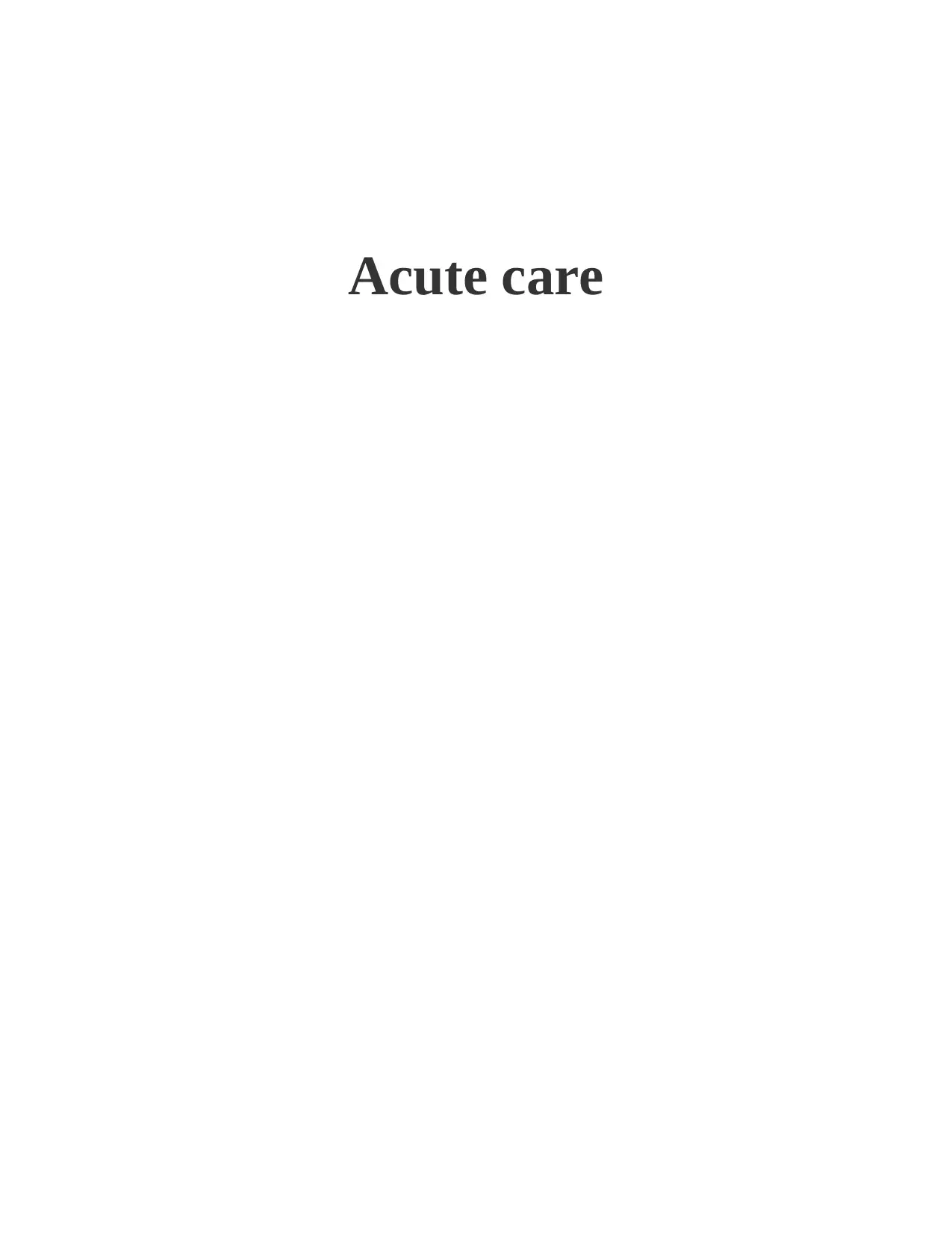
Acute care
Paraphrase This Document
Need a fresh take? Get an instant paraphrase of this document with our AI Paraphraser
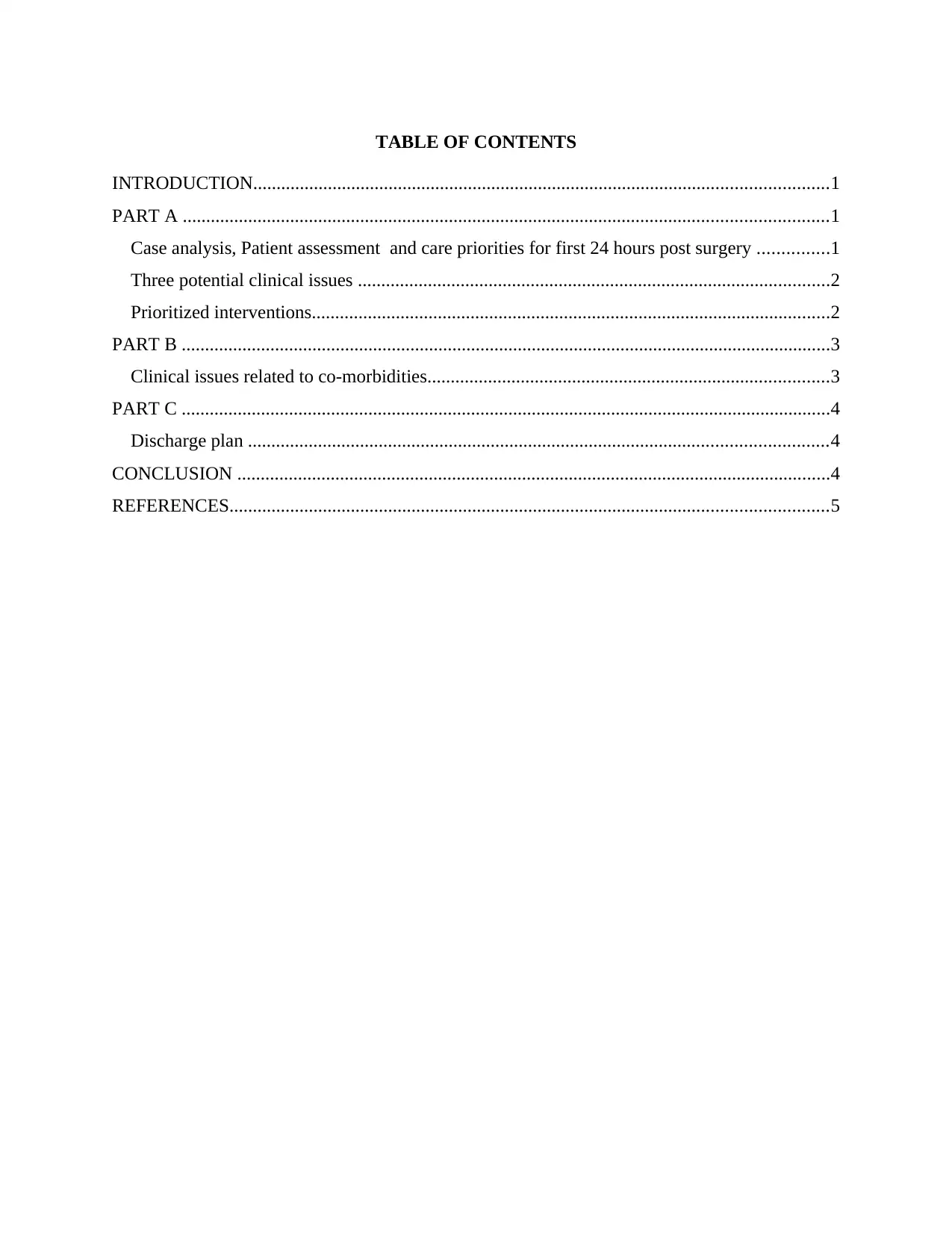
TABLE OF CONTENTS
INTRODUCTION...........................................................................................................................1
PART A ..........................................................................................................................................1
Case analysis, Patient assessment and care priorities for first 24 hours post surgery ...............1
Three potential clinical issues .....................................................................................................2
Prioritized interventions...............................................................................................................2
PART B ...........................................................................................................................................3
Clinical issues related to co-morbidities......................................................................................3
PART C ...........................................................................................................................................4
Discharge plan ............................................................................................................................4
CONCLUSION ...............................................................................................................................4
REFERENCES................................................................................................................................5
INTRODUCTION...........................................................................................................................1
PART A ..........................................................................................................................................1
Case analysis, Patient assessment and care priorities for first 24 hours post surgery ...............1
Three potential clinical issues .....................................................................................................2
Prioritized interventions...............................................................................................................2
PART B ...........................................................................................................................................3
Clinical issues related to co-morbidities......................................................................................3
PART C ...........................................................................................................................................4
Discharge plan ............................................................................................................................4
CONCLUSION ...............................................................................................................................4
REFERENCES................................................................................................................................5
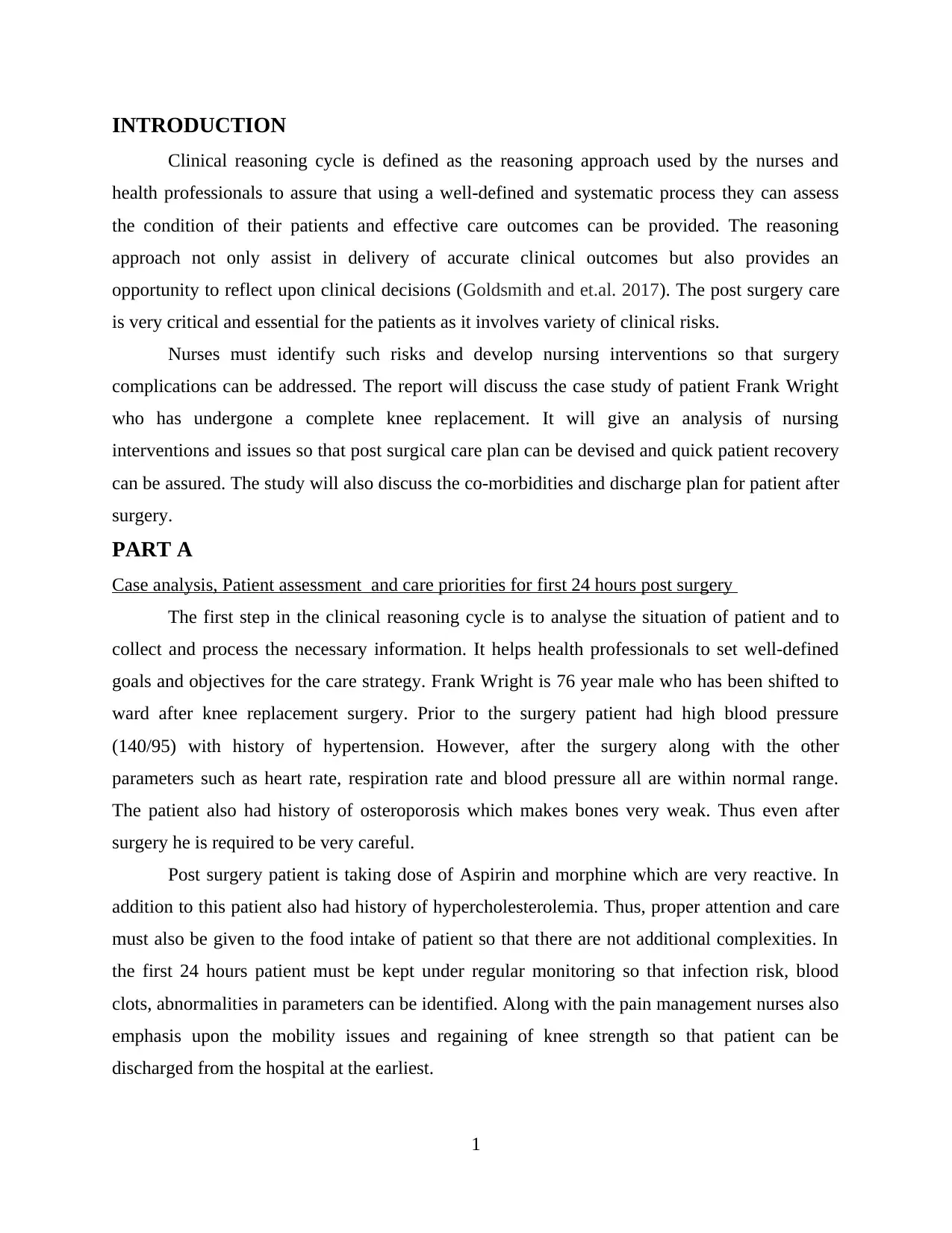
INTRODUCTION
Clinical reasoning cycle is defined as the reasoning approach used by the nurses and
health professionals to assure that using a well-defined and systematic process they can assess
the condition of their patients and effective care outcomes can be provided. The reasoning
approach not only assist in delivery of accurate clinical outcomes but also provides an
opportunity to reflect upon clinical decisions (Goldsmith and et.al. 2017). The post surgery care
is very critical and essential for the patients as it involves variety of clinical risks.
Nurses must identify such risks and develop nursing interventions so that surgery
complications can be addressed. The report will discuss the case study of patient Frank Wright
who has undergone a complete knee replacement. It will give an analysis of nursing
interventions and issues so that post surgical care plan can be devised and quick patient recovery
can be assured. The study will also discuss the co-morbidities and discharge plan for patient after
surgery.
PART A
Case analysis, Patient assessment and care priorities for first 24 hours post surgery
The first step in the clinical reasoning cycle is to analyse the situation of patient and to
collect and process the necessary information. It helps health professionals to set well-defined
goals and objectives for the care strategy. Frank Wright is 76 year male who has been shifted to
ward after knee replacement surgery. Prior to the surgery patient had high blood pressure
(140/95) with history of hypertension. However, after the surgery along with the other
parameters such as heart rate, respiration rate and blood pressure all are within normal range.
The patient also had history of osteroporosis which makes bones very weak. Thus even after
surgery he is required to be very careful.
Post surgery patient is taking dose of Aspirin and morphine which are very reactive. In
addition to this patient also had history of hypercholesterolemia. Thus, proper attention and care
must also be given to the food intake of patient so that there are not additional complexities. In
the first 24 hours patient must be kept under regular monitoring so that infection risk, blood
clots, abnormalities in parameters can be identified. Along with the pain management nurses also
emphasis upon the mobility issues and regaining of knee strength so that patient can be
discharged from the hospital at the earliest.
1
Clinical reasoning cycle is defined as the reasoning approach used by the nurses and
health professionals to assure that using a well-defined and systematic process they can assess
the condition of their patients and effective care outcomes can be provided. The reasoning
approach not only assist in delivery of accurate clinical outcomes but also provides an
opportunity to reflect upon clinical decisions (Goldsmith and et.al. 2017). The post surgery care
is very critical and essential for the patients as it involves variety of clinical risks.
Nurses must identify such risks and develop nursing interventions so that surgery
complications can be addressed. The report will discuss the case study of patient Frank Wright
who has undergone a complete knee replacement. It will give an analysis of nursing
interventions and issues so that post surgical care plan can be devised and quick patient recovery
can be assured. The study will also discuss the co-morbidities and discharge plan for patient after
surgery.
PART A
Case analysis, Patient assessment and care priorities for first 24 hours post surgery
The first step in the clinical reasoning cycle is to analyse the situation of patient and to
collect and process the necessary information. It helps health professionals to set well-defined
goals and objectives for the care strategy. Frank Wright is 76 year male who has been shifted to
ward after knee replacement surgery. Prior to the surgery patient had high blood pressure
(140/95) with history of hypertension. However, after the surgery along with the other
parameters such as heart rate, respiration rate and blood pressure all are within normal range.
The patient also had history of osteroporosis which makes bones very weak. Thus even after
surgery he is required to be very careful.
Post surgery patient is taking dose of Aspirin and morphine which are very reactive. In
addition to this patient also had history of hypercholesterolemia. Thus, proper attention and care
must also be given to the food intake of patient so that there are not additional complexities. In
the first 24 hours patient must be kept under regular monitoring so that infection risk, blood
clots, abnormalities in parameters can be identified. Along with the pain management nurses also
emphasis upon the mobility issues and regaining of knee strength so that patient can be
discharged from the hospital at the earliest.
1
⊘ This is a preview!⊘
Do you want full access?
Subscribe today to unlock all pages.

Trusted by 1+ million students worldwide
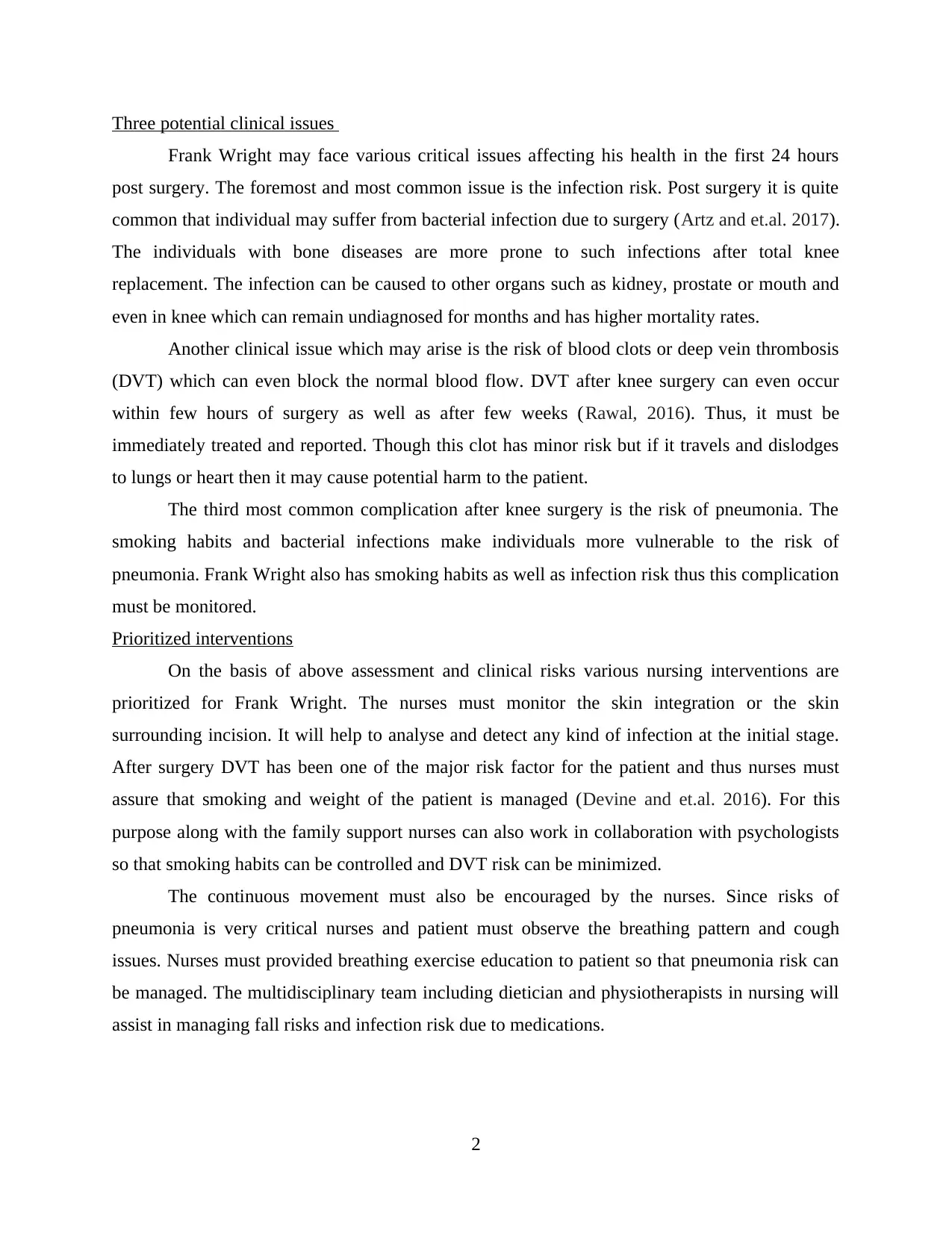
Three potential clinical issues
Frank Wright may face various critical issues affecting his health in the first 24 hours
post surgery. The foremost and most common issue is the infection risk. Post surgery it is quite
common that individual may suffer from bacterial infection due to surgery (Artz and et.al. 2017).
The individuals with bone diseases are more prone to such infections after total knee
replacement. The infection can be caused to other organs such as kidney, prostate or mouth and
even in knee which can remain undiagnosed for months and has higher mortality rates.
Another clinical issue which may arise is the risk of blood clots or deep vein thrombosis
(DVT) which can even block the normal blood flow. DVT after knee surgery can even occur
within few hours of surgery as well as after few weeks (Rawal, 2016). Thus, it must be
immediately treated and reported. Though this clot has minor risk but if it travels and dislodges
to lungs or heart then it may cause potential harm to the patient.
The third most common complication after knee surgery is the risk of pneumonia. The
smoking habits and bacterial infections make individuals more vulnerable to the risk of
pneumonia. Frank Wright also has smoking habits as well as infection risk thus this complication
must be monitored.
Prioritized interventions
On the basis of above assessment and clinical risks various nursing interventions are
prioritized for Frank Wright. The nurses must monitor the skin integration or the skin
surrounding incision. It will help to analyse and detect any kind of infection at the initial stage.
After surgery DVT has been one of the major risk factor for the patient and thus nurses must
assure that smoking and weight of the patient is managed (Devine and et.al. 2016). For this
purpose along with the family support nurses can also work in collaboration with psychologists
so that smoking habits can be controlled and DVT risk can be minimized.
The continuous movement must also be encouraged by the nurses. Since risks of
pneumonia is very critical nurses and patient must observe the breathing pattern and cough
issues. Nurses must provided breathing exercise education to patient so that pneumonia risk can
be managed. The multidisciplinary team including dietician and physiotherapists in nursing will
assist in managing fall risks and infection risk due to medications.
2
Frank Wright may face various critical issues affecting his health in the first 24 hours
post surgery. The foremost and most common issue is the infection risk. Post surgery it is quite
common that individual may suffer from bacterial infection due to surgery (Artz and et.al. 2017).
The individuals with bone diseases are more prone to such infections after total knee
replacement. The infection can be caused to other organs such as kidney, prostate or mouth and
even in knee which can remain undiagnosed for months and has higher mortality rates.
Another clinical issue which may arise is the risk of blood clots or deep vein thrombosis
(DVT) which can even block the normal blood flow. DVT after knee surgery can even occur
within few hours of surgery as well as after few weeks (Rawal, 2016). Thus, it must be
immediately treated and reported. Though this clot has minor risk but if it travels and dislodges
to lungs or heart then it may cause potential harm to the patient.
The third most common complication after knee surgery is the risk of pneumonia. The
smoking habits and bacterial infections make individuals more vulnerable to the risk of
pneumonia. Frank Wright also has smoking habits as well as infection risk thus this complication
must be monitored.
Prioritized interventions
On the basis of above assessment and clinical risks various nursing interventions are
prioritized for Frank Wright. The nurses must monitor the skin integration or the skin
surrounding incision. It will help to analyse and detect any kind of infection at the initial stage.
After surgery DVT has been one of the major risk factor for the patient and thus nurses must
assure that smoking and weight of the patient is managed (Devine and et.al. 2016). For this
purpose along with the family support nurses can also work in collaboration with psychologists
so that smoking habits can be controlled and DVT risk can be minimized.
The continuous movement must also be encouraged by the nurses. Since risks of
pneumonia is very critical nurses and patient must observe the breathing pattern and cough
issues. Nurses must provided breathing exercise education to patient so that pneumonia risk can
be managed. The multidisciplinary team including dietician and physiotherapists in nursing will
assist in managing fall risks and infection risk due to medications.
2
Paraphrase This Document
Need a fresh take? Get an instant paraphrase of this document with our AI Paraphraser
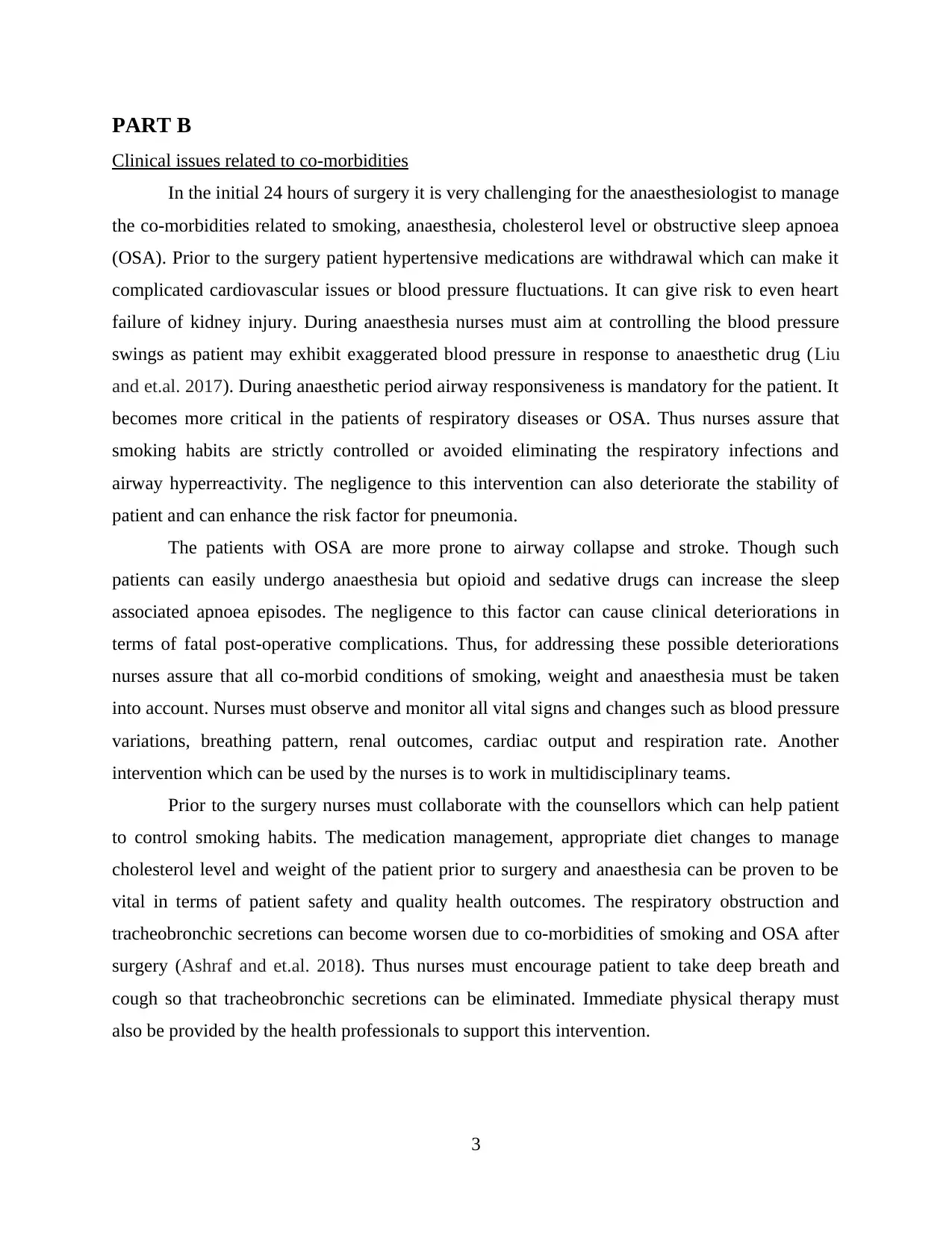
PART B
Clinical issues related to co-morbidities
In the initial 24 hours of surgery it is very challenging for the anaesthesiologist to manage
the co-morbidities related to smoking, anaesthesia, cholesterol level or obstructive sleep apnoea
(OSA). Prior to the surgery patient hypertensive medications are withdrawal which can make it
complicated cardiovascular issues or blood pressure fluctuations. It can give risk to even heart
failure of kidney injury. During anaesthesia nurses must aim at controlling the blood pressure
swings as patient may exhibit exaggerated blood pressure in response to anaesthetic drug (Liu
and et.al. 2017). During anaesthetic period airway responsiveness is mandatory for the patient. It
becomes more critical in the patients of respiratory diseases or OSA. Thus nurses assure that
smoking habits are strictly controlled or avoided eliminating the respiratory infections and
airway hyperreactivity. The negligence to this intervention can also deteriorate the stability of
patient and can enhance the risk factor for pneumonia.
The patients with OSA are more prone to airway collapse and stroke. Though such
patients can easily undergo anaesthesia but opioid and sedative drugs can increase the sleep
associated apnoea episodes. The negligence to this factor can cause clinical deteriorations in
terms of fatal post-operative complications. Thus, for addressing these possible deteriorations
nurses assure that all co-morbid conditions of smoking, weight and anaesthesia must be taken
into account. Nurses must observe and monitor all vital signs and changes such as blood pressure
variations, breathing pattern, renal outcomes, cardiac output and respiration rate. Another
intervention which can be used by the nurses is to work in multidisciplinary teams.
Prior to the surgery nurses must collaborate with the counsellors which can help patient
to control smoking habits. The medication management, appropriate diet changes to manage
cholesterol level and weight of the patient prior to surgery and anaesthesia can be proven to be
vital in terms of patient safety and quality health outcomes. The respiratory obstruction and
tracheobronchic secretions can become worsen due to co-morbidities of smoking and OSA after
surgery (Ashraf and et.al. 2018). Thus nurses must encourage patient to take deep breath and
cough so that tracheobronchic secretions can be eliminated. Immediate physical therapy must
also be provided by the health professionals to support this intervention.
3
Clinical issues related to co-morbidities
In the initial 24 hours of surgery it is very challenging for the anaesthesiologist to manage
the co-morbidities related to smoking, anaesthesia, cholesterol level or obstructive sleep apnoea
(OSA). Prior to the surgery patient hypertensive medications are withdrawal which can make it
complicated cardiovascular issues or blood pressure fluctuations. It can give risk to even heart
failure of kidney injury. During anaesthesia nurses must aim at controlling the blood pressure
swings as patient may exhibit exaggerated blood pressure in response to anaesthetic drug (Liu
and et.al. 2017). During anaesthetic period airway responsiveness is mandatory for the patient. It
becomes more critical in the patients of respiratory diseases or OSA. Thus nurses assure that
smoking habits are strictly controlled or avoided eliminating the respiratory infections and
airway hyperreactivity. The negligence to this intervention can also deteriorate the stability of
patient and can enhance the risk factor for pneumonia.
The patients with OSA are more prone to airway collapse and stroke. Though such
patients can easily undergo anaesthesia but opioid and sedative drugs can increase the sleep
associated apnoea episodes. The negligence to this factor can cause clinical deteriorations in
terms of fatal post-operative complications. Thus, for addressing these possible deteriorations
nurses assure that all co-morbid conditions of smoking, weight and anaesthesia must be taken
into account. Nurses must observe and monitor all vital signs and changes such as blood pressure
variations, breathing pattern, renal outcomes, cardiac output and respiration rate. Another
intervention which can be used by the nurses is to work in multidisciplinary teams.
Prior to the surgery nurses must collaborate with the counsellors which can help patient
to control smoking habits. The medication management, appropriate diet changes to manage
cholesterol level and weight of the patient prior to surgery and anaesthesia can be proven to be
vital in terms of patient safety and quality health outcomes. The respiratory obstruction and
tracheobronchic secretions can become worsen due to co-morbidities of smoking and OSA after
surgery (Ashraf and et.al. 2018). Thus nurses must encourage patient to take deep breath and
cough so that tracheobronchic secretions can be eliminated. Immediate physical therapy must
also be provided by the health professionals to support this intervention.
3
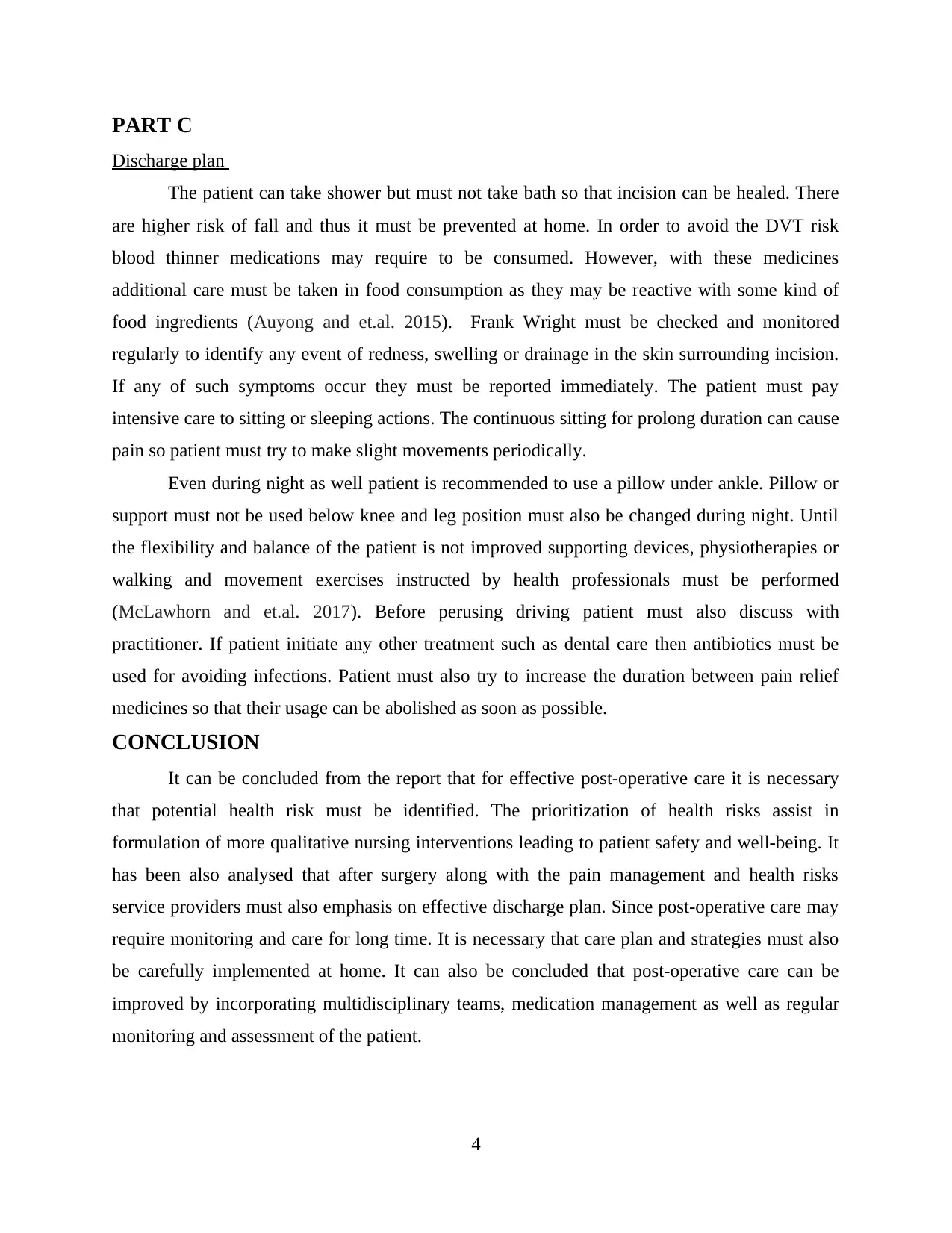
PART C
Discharge plan
The patient can take shower but must not take bath so that incision can be healed. There
are higher risk of fall and thus it must be prevented at home. In order to avoid the DVT risk
blood thinner medications may require to be consumed. However, with these medicines
additional care must be taken in food consumption as they may be reactive with some kind of
food ingredients (Auyong and et.al. 2015). Frank Wright must be checked and monitored
regularly to identify any event of redness, swelling or drainage in the skin surrounding incision.
If any of such symptoms occur they must be reported immediately. The patient must pay
intensive care to sitting or sleeping actions. The continuous sitting for prolong duration can cause
pain so patient must try to make slight movements periodically.
Even during night as well patient is recommended to use a pillow under ankle. Pillow or
support must not be used below knee and leg position must also be changed during night. Until
the flexibility and balance of the patient is not improved supporting devices, physiotherapies or
walking and movement exercises instructed by health professionals must be performed
(McLawhorn and et.al. 2017). Before perusing driving patient must also discuss with
practitioner. If patient initiate any other treatment such as dental care then antibiotics must be
used for avoiding infections. Patient must also try to increase the duration between pain relief
medicines so that their usage can be abolished as soon as possible.
CONCLUSION
It can be concluded from the report that for effective post-operative care it is necessary
that potential health risk must be identified. The prioritization of health risks assist in
formulation of more qualitative nursing interventions leading to patient safety and well-being. It
has been also analysed that after surgery along with the pain management and health risks
service providers must also emphasis on effective discharge plan. Since post-operative care may
require monitoring and care for long time. It is necessary that care plan and strategies must also
be carefully implemented at home. It can also be concluded that post-operative care can be
improved by incorporating multidisciplinary teams, medication management as well as regular
monitoring and assessment of the patient.
4
Discharge plan
The patient can take shower but must not take bath so that incision can be healed. There
are higher risk of fall and thus it must be prevented at home. In order to avoid the DVT risk
blood thinner medications may require to be consumed. However, with these medicines
additional care must be taken in food consumption as they may be reactive with some kind of
food ingredients (Auyong and et.al. 2015). Frank Wright must be checked and monitored
regularly to identify any event of redness, swelling or drainage in the skin surrounding incision.
If any of such symptoms occur they must be reported immediately. The patient must pay
intensive care to sitting or sleeping actions. The continuous sitting for prolong duration can cause
pain so patient must try to make slight movements periodically.
Even during night as well patient is recommended to use a pillow under ankle. Pillow or
support must not be used below knee and leg position must also be changed during night. Until
the flexibility and balance of the patient is not improved supporting devices, physiotherapies or
walking and movement exercises instructed by health professionals must be performed
(McLawhorn and et.al. 2017). Before perusing driving patient must also discuss with
practitioner. If patient initiate any other treatment such as dental care then antibiotics must be
used for avoiding infections. Patient must also try to increase the duration between pain relief
medicines so that their usage can be abolished as soon as possible.
CONCLUSION
It can be concluded from the report that for effective post-operative care it is necessary
that potential health risk must be identified. The prioritization of health risks assist in
formulation of more qualitative nursing interventions leading to patient safety and well-being. It
has been also analysed that after surgery along with the pain management and health risks
service providers must also emphasis on effective discharge plan. Since post-operative care may
require monitoring and care for long time. It is necessary that care plan and strategies must also
be carefully implemented at home. It can also be concluded that post-operative care can be
improved by incorporating multidisciplinary teams, medication management as well as regular
monitoring and assessment of the patient.
4
⊘ This is a preview!⊘
Do you want full access?
Subscribe today to unlock all pages.

Trusted by 1+ million students worldwide
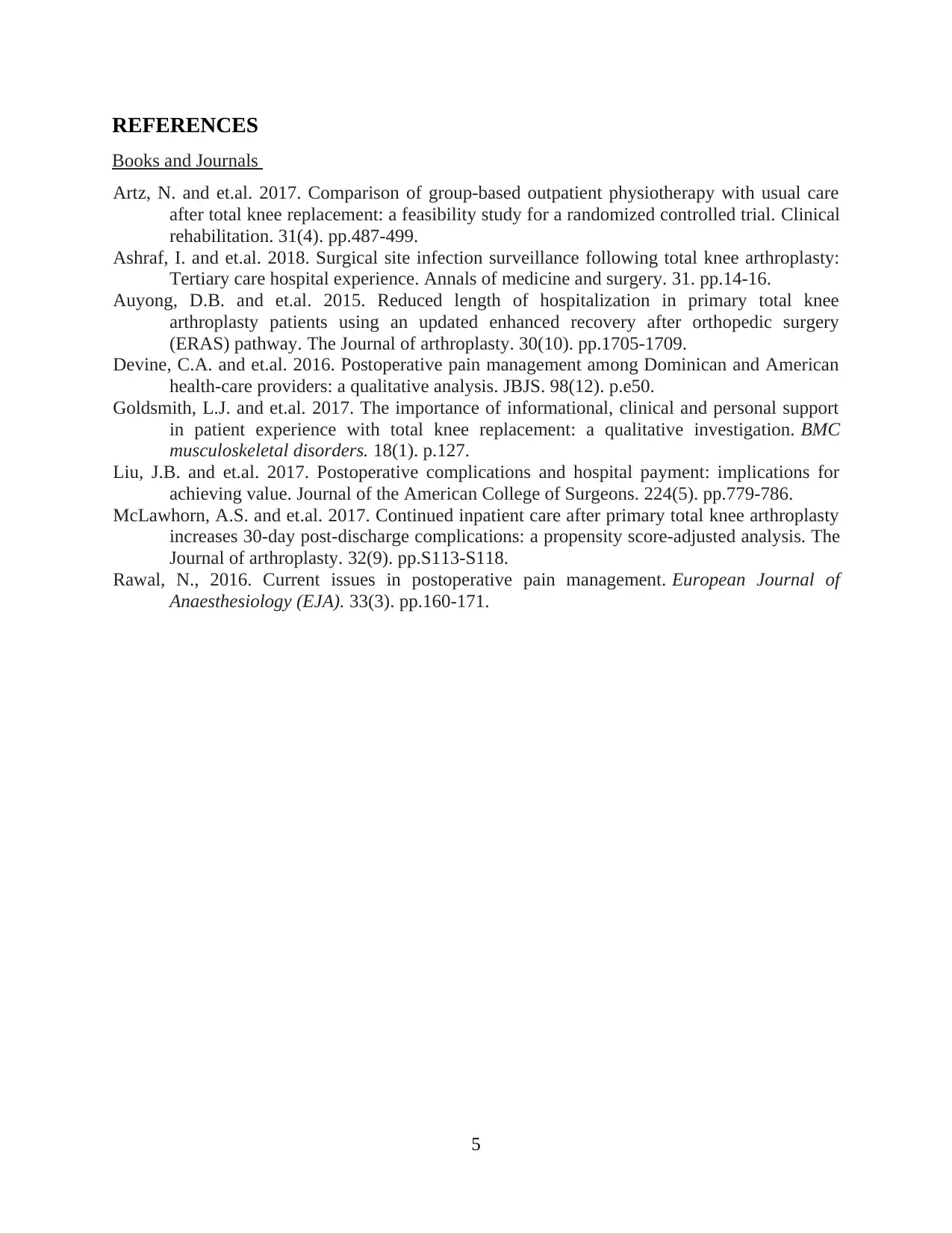
REFERENCES
Books and Journals
Artz, N. and et.al. 2017. Comparison of group-based outpatient physiotherapy with usual care
after total knee replacement: a feasibility study for a randomized controlled trial. Clinical
rehabilitation. 31(4). pp.487-499.
Ashraf, I. and et.al. 2018. Surgical site infection surveillance following total knee arthroplasty:
Tertiary care hospital experience. Annals of medicine and surgery. 31. pp.14-16.
Auyong, D.B. and et.al. 2015. Reduced length of hospitalization in primary total knee
arthroplasty patients using an updated enhanced recovery after orthopedic surgery
(ERAS) pathway. The Journal of arthroplasty. 30(10). pp.1705-1709.
Devine, C.A. and et.al. 2016. Postoperative pain management among Dominican and American
health-care providers: a qualitative analysis. JBJS. 98(12). p.e50.
Goldsmith, L.J. and et.al. 2017. The importance of informational, clinical and personal support
in patient experience with total knee replacement: a qualitative investigation. BMC
musculoskeletal disorders. 18(1). p.127.
Liu, J.B. and et.al. 2017. Postoperative complications and hospital payment: implications for
achieving value. Journal of the American College of Surgeons. 224(5). pp.779-786.
McLawhorn, A.S. and et.al. 2017. Continued inpatient care after primary total knee arthroplasty
increases 30-day post-discharge complications: a propensity score-adjusted analysis. The
Journal of arthroplasty. 32(9). pp.S113-S118.
Rawal, N., 2016. Current issues in postoperative pain management. European Journal of
Anaesthesiology (EJA). 33(3). pp.160-171.
5
Books and Journals
Artz, N. and et.al. 2017. Comparison of group-based outpatient physiotherapy with usual care
after total knee replacement: a feasibility study for a randomized controlled trial. Clinical
rehabilitation. 31(4). pp.487-499.
Ashraf, I. and et.al. 2018. Surgical site infection surveillance following total knee arthroplasty:
Tertiary care hospital experience. Annals of medicine and surgery. 31. pp.14-16.
Auyong, D.B. and et.al. 2015. Reduced length of hospitalization in primary total knee
arthroplasty patients using an updated enhanced recovery after orthopedic surgery
(ERAS) pathway. The Journal of arthroplasty. 30(10). pp.1705-1709.
Devine, C.A. and et.al. 2016. Postoperative pain management among Dominican and American
health-care providers: a qualitative analysis. JBJS. 98(12). p.e50.
Goldsmith, L.J. and et.al. 2017. The importance of informational, clinical and personal support
in patient experience with total knee replacement: a qualitative investigation. BMC
musculoskeletal disorders. 18(1). p.127.
Liu, J.B. and et.al. 2017. Postoperative complications and hospital payment: implications for
achieving value. Journal of the American College of Surgeons. 224(5). pp.779-786.
McLawhorn, A.S. and et.al. 2017. Continued inpatient care after primary total knee arthroplasty
increases 30-day post-discharge complications: a propensity score-adjusted analysis. The
Journal of arthroplasty. 32(9). pp.S113-S118.
Rawal, N., 2016. Current issues in postoperative pain management. European Journal of
Anaesthesiology (EJA). 33(3). pp.160-171.
5
Paraphrase This Document
Need a fresh take? Get an instant paraphrase of this document with our AI Paraphraser

6

7
⊘ This is a preview!⊘
Do you want full access?
Subscribe today to unlock all pages.

Trusted by 1+ million students worldwide

8
Paraphrase This Document
Need a fresh take? Get an instant paraphrase of this document with our AI Paraphraser

9
1 out of 11
Related Documents
Your All-in-One AI-Powered Toolkit for Academic Success.
+13062052269
info@desklib.com
Available 24*7 on WhatsApp / Email
![[object Object]](/_next/static/media/star-bottom.7253800d.svg)
Unlock your academic potential
Copyright © 2020–2025 A2Z Services. All Rights Reserved. Developed and managed by ZUCOL.




